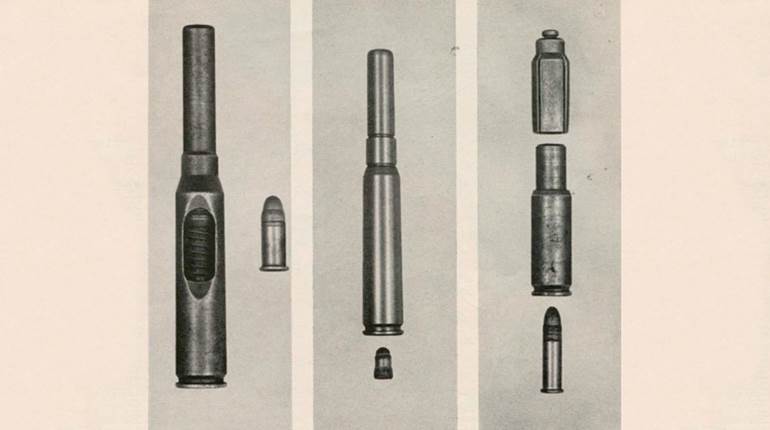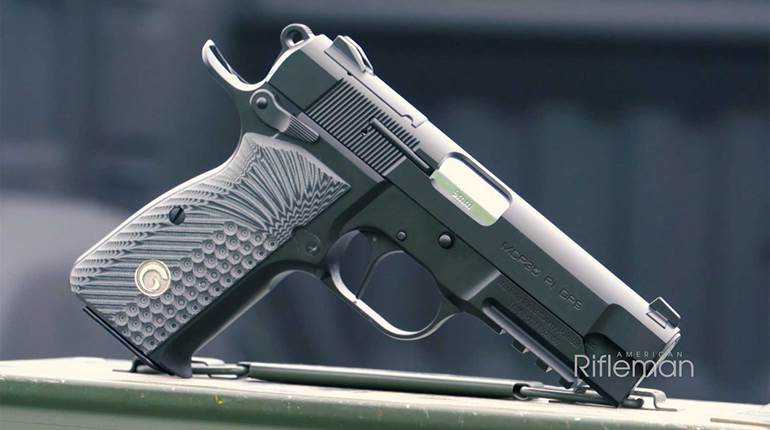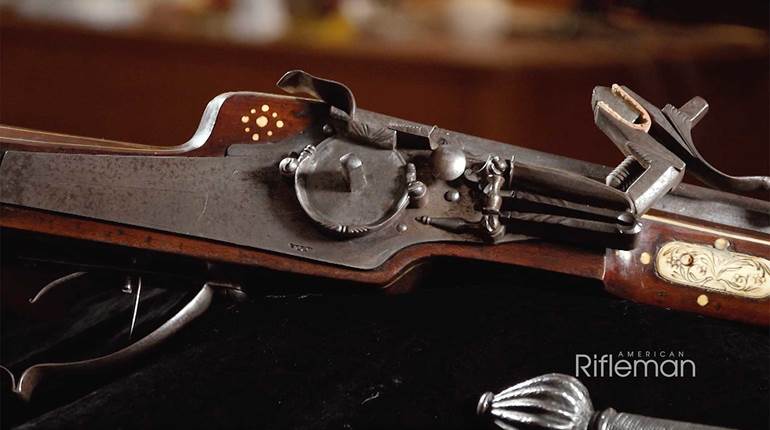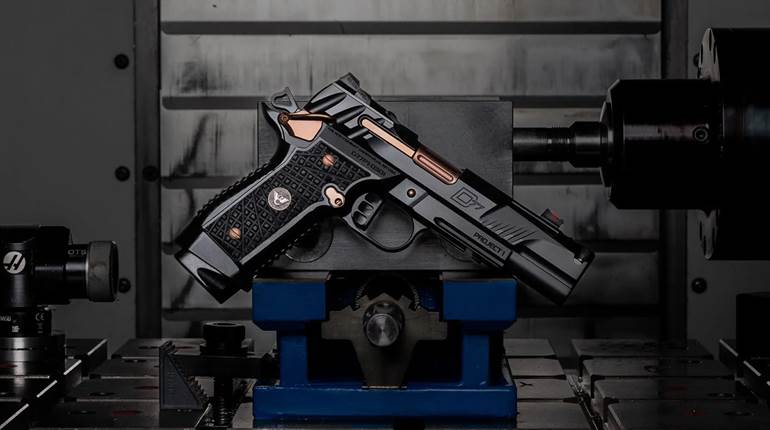
Cal. .22 Short adapter for U.S. M1903 Gallery Practice rifle (l.). German rifled adapter for 4 mm center-fire cartridge for use in 8 mm rifle (center). Cartridge holder assembly used in U.S. cal. .22 Machine Gun Trainer (cal. .22 Long Rifle)(r.).
This article was first published in American Rifleman, May, 1966
The breech-loader was hardly introduced before shooters began to search for a more economical way to feed it. The muzzle-loader could be given more or less powder depending on the situation, but fixed cartridges had to be used as they were. Reloading helped, but many of the calibers at this early stage were rimfires and unreload-able. One solution was the adapter, which permitted firing a smaller, more economical cartridge in a large-bore rifle or shotgun.
When the first such adapter appeared is not known. The British adopted the .577 Snider in 1866, and replaced it with the Martini-Henry a few years later. It is known that there was a steel adapter for the Snider, chambered for the cal. .22 CB cartridge. It was bored off-center, so that the regular firing pin could strike the rim.
An adapter for the Martini-Henry is also known. Made of brass, and measuring 3 1/16" in length, it appears much like the loaded .577/.450 cartridge except for the longitudinal hole. It was apparently intended for use with a center-fire pistol cartridge, since it is not bored off-center.
On Apr. 23, 1901, a patent was granted for the Elterich Rifle Bullet Shell. This adapter was manufactured by the Stevens Arms & Tool Co. and known as the R.B.S. The outer case of brass—to the dimensions of the shotgun shell—was slotted and bulged outward to produce a springy effect which would hold and center it in the chamber. Inside was fitted a rifled steel barrel chambered for a small center-fire cartridge, to make a shotgun into a 'practical rifle'.

Elterich Shell Models
The Elterich Rifle Bullet Shell was produced for 10-ga., 12-ga., and 16-ga. shotguns in 3 different models. The No. 1 was for use in repeating guns. The No. 2 was equipped with an extractor, designed so that it would adjust to the ejectors found on most single-barrel and double-barrel shotguns. Both models were 2Vz" long, chambered for the same cartridge (the .32 S&W), and priced at $3.50 in 10-ga., and $3.00 in 12-ga. and 16-ga.
The No. 3 model was for single-barrel and double-barrel guns only, since it had an additional 1 ½” of barrel which gave it an over-all length of 4". The 12-ga. and 16-ga. were available chambered for the .25-20 Winchester, .32-20 Winchester, .32 S&W, and .32 Colt New Police cartridges, and cost $3.50. The 10-ga. was available in the same calibers plus the .38 S&W Special and cost $4. The No. 3 could also be obtained on special order with 6" and 10" barrels at $5 and $6, and with a 10" smoothbore barrel for shot cartridges at $5.
It was claimed that the No. 1 and No. 2 models were practical to 100 yds. and the No. 3 to 200 yds. The latter figure is asking quite a bit of a 4" barrel in any of the calibers available, to say nothing of the sighting equipment of the shotgun.
In the 10" barrels, the handiness of the 2 ½” and 4" models was eliminated, making the Rifle Bullet Shell simply a spare rifle barrel.
An adapter known as Brayton's Auxiliary Cartridge also appeared about this time. It looked like a cartridge which had been cut off at the junction of the shoulder and neck. A cal. .32 S&W cartridge was slipped base-first into the opening at the shoulder and gripped there by spring tension. The loaded adapter could then be fed through the magazine as though it were a regular cartridge, which it appeared to be. The Auxiliary Cartridge contained its own firing pin, held in place by a small screw. So far as the author knows, this adapter was available only for the .303 Savage cartridge, although it could possibly have been produced for the .30-30 Winchester.
MI903 Cartridge Holder
The U.S. Gallery-Practice Rifle, Cal. .22, Model of 1903, and its ammunition appeared about 1907. While not an adapter in the regular sense of the term (i.e., to use more economical ammunition in a large-bore rifle or shotgun, while retaining the original caliber), the device used in the M1903 Gallery Practice Rifle was a cartridge holder. The only change necessary in the M1903 rifle was the installation of a cal. .22 barrel with a chamber slightly shorter than the regular Service rifle to prevent insertion of the cal. .30 Service cartridge, and a rear sight graduated for the .22 short cartridge. The blackened steel Hoffer-Thompson holders, complete with spring-loaded firing pin to fire the .22 short rimfire cartridge, were issued in quantities of 25 with each rifle. In use, a .22 short cartridge was inserted through a loading port in the side of each holder. The loaded holders were then placed in the magazine of the unaltered M1903 action in the same manner as the Service cartridge. Operation of the action remained the same and the holders were ejected the same as empty .30-'06 cases. After punching out the fired .22 short and replacing it with a loaded one, the holders were ready for use again.
The British used a similar adapter in .303 rifle barrels relined to cal. .22. The adapter consisted of a steel holder looking like a .303 British cartridge with a long cylindrical bullet and chambered for the .22 rimfire cartridge.
Germany and Austria also used training adapters, but of a different type. One German adapter was the same size externally as the 8x57 mm. Service cartridge. The neck portion was reamed to accept a light lead or jacketed 8 mm. bullet which was propelled by an RWS 4 mm. M20 blank that fitted into the adapter in the normal primer position. The use of light bullets of the regular caliber in the adapters made changing the barrel unnecessary. The M20 is a bottlenecked rimless (without extractor groove) center-fire cartridge. In the ball form it is used, with and without an adapter, for target shooting in handguns and rifles.
The Birmingham, England, firm of Parker-Hale marketed an adapter for the Vickers machine gun. This adapter was made of steel to the dimensions of the .303 British cartridge with a long cylindrical bullet, and rifled with 10 shallow lands and grooves. The ammunition used was a special 4 mm. center-fire manufactured by Kynoch for the Parker-Hale adapter. Complete with 7-gr. lead ball, the cartridge resembled the M20, except for being rimmed, and looked like a .22 CB cap necked down to 4 mm.
According to the manufacturer, "no alteration whatsoever is necessary to use these adaptors and cartridges in Vickers guns. The bullet when it leaves the adaptor flies down the centre of the .303 in. barrel and can be relied on to group into half an inch at 12 ft. from the muzzle."
In a Vickers machine gun such accuracy may have been possible, but when fired in a cal. .303 rifle any attempt to produce a group resulted in what appeared to be a buckshot pattern.
Developments In The 1930's
The 1930’s saw an increase in the number of adapters on the market. Times were difficult for both military personnel and civilians. Some reloading was done, but less than is done today, and the adapter offered a possible solution to firing a big-bore rifle when full charges were not needed.
The U.S. Army used at least 2 forms of such adapters through World War II. The first was developed by the Ordnance Department about 1935 and was known as the Sub-Caliber Attachment, Cal. .22 TI. Made of steel, the cartridge holder resembled a shortened .30-'06 case, and when a cal. .22 long rifle cartridge was inserted into the base the entire assembly reminded one of an empty primed case with an over-size primer. The Browning M1917 water-cooled machine gun was altered by replacing the cal. .30 barrel with a cal. .22 barrel counterbored at the rear to accept the .22 adapter and a Williams-type floating-chamber piston. Standard 250-round cloth belts were employed and operation was automatic. Later the U. S. Cal. .22 Machine Gun Trainers M3 (for the M1917A1 gun), M4 (for the M1919A4), and M5 (M2 Aircraft) used similar cartridge holders with slotted steel belt adapters.

Marble and Winchester Adapters
Adapters manufactured by the Marble Arms Corp. of Gladstone, Mich., were known as Marble's Auxiliary Cartridges. At one time the Auxiliary Cartridges were available for some 25 different calibers and had even been adopted by several state militias for target practice. There were 2 forms. One was slotted and was sprung apart to receive the rim of the pistol cartridge, while the other, generally for the cal. .22 rimfire cartridges, was not slotted, making it necessary to load the rimfire cartridge from the rear. Both types held the loaded cartridge at the forward end of the adapter and had separate firing pins of their own. Originally costing 75 cents in the 1930's, when they were discontinued about 1962 the price was $2.25. Today, about the only 2 of the Marble Auxiliary Cartridges that might be worth having would be the 161 and 174 sizes for the .220 Swift and the .22 Savage Hi-Power. These use the .22 long rifle cartridges and would be handy for plinking. The other sizes use pistol cartridges that are more expensive than reloads of the regular rifle cartridge.
Supplemental Chambers
For many years Winchester offered Supplemental Chambers for the .30-'06, .30-40 Krag, .30-30 Winchester, .303 Savage, and .303 British cartridges. Made of steel and resembling empty cases, the Supplemental Chambers were intended to take a .32 S&W pistol cartridge loaded into the rear for range and indoor target shooting. Chambers for the .32 Winchester Special and, 32-40 calibers were also available, to be used with .32 Short Colt or .32 Long Colt cartridges. Cost of either type of chamber was 50 cents in 1939.
An adapter of quite different kind was manufactured by the National Arms Co. of San Francisco, Calif. Known as the Zip Reload Chamber, it was available in at least 9 calibers from 6.5 Mannlicher to .30-'06. Lightweight bullets of standard caliber were used, along with a slightly bottlenecked rimfire blank manufactured by the Peters Cartridge Co. The Zip Chamber unscrewed in the middle to accept the blank cartridge. With the bullet in position in the neck, it was difficult to tell the reloaded Zip from a regular cartridge. The Zip Chambers cost $1 each in 1939, with reloads available at $1.50 for 50 blank Propellant Cartridges and 50 bullets.
A device somewhat similar to the Zip was used in France for military training. The basic dimensions were those of the 7.5 mm MAS cartridge. The adapter came apart near the base so that a .22 rimfire cartridge could be inserted, and a special cal. .22 barrel was used, making the combination somewhat similar to the cal. .22 U. S. Gallery Rifle, Model of 1903.
Several conversion units were produced in Europe during this period to permit firing of 4 mm M20 cartridges in handguns. The units use special 4 mm barrels, many with adapters the size of the regular cartridge for which the handgun is chambered. In use the adapters are loaded by pushing a 4 mm cartridge into the primer position. They are then fed manually from the regular pistol magazine (the 4 mm. cartridge will not operate the mechanism).

Adapters For Shotguns
In 1956 the Armax Co., Fort Worth, Tex., began the distribution of an adapter known as the Armax Auxiliary Shotgun Barrel. Available in 12-ga., 16-ga., and 20-ga., it consisted of a rifled steel cylinder of shotshell dimensions, bored off-center to enable the firing pin to strike the rim of the .22 cartridge. Two resilient rings prevented metal-to-metal contact and centered the Auxiliary unit in the chamber. Designed for firing in all types of shotguns from single-shots to automatics (it was not designed to operate the mechanism), the Armax Auxiliary barrel was claimed to give groups of less than 2" at 50 yds. Any slight change of location of the unit within the chamber caused a material change in the point of impact.
The German Rekord Insert Barrel, available in 12-ga. and 16-ga., allows the use of the .22 long rifle cartridge in shotguns. Again the bore is offset, but the insert barrel is held securely in the gun and shoots accurately. It is 13 ¾ " long, and therefore an insert barrel rather than an adapter.
An auxiliary rifle barrel for shotguns, similar to the present. Browning and Poly-Choke .410-bore insert barrels, was manufactured in the 1880's. Known as Shelton's Auxiliary Rifle, it was available in cals. .32, .38, .40 Target, .44, .45 Gov't., and .45 Express to fit standard 10-ga. and 12-ga. guns, and was advertised as being as easily inserted and removed as a shotshell. A special folding sight for the shotgun tang was also offered, which should have helped the accuracy of such a combination.
Adapters have long been available to allow the use of .410 cartridges in 12-ga. shotguns. They will not function through the mechanism of pumps or automatics and therefore must be used in single-shots, double-barrels, or Drillings. A few of the short models, such as the Parker-Hale, one French model, and Savage's Four-Tenner, can be carried in the pocket. The ones currently manufactured by Poly-Choke and Browning are about 16" long and must be used as insert barrels.
Handgun Adapters
Several firms have produced forms of adapters for use in handguns. Steel duplicates of regular cartridges, these were bored and rifled to accept lead shot and a large pistol primer. Two such adapters were produced by California firms—the Tri-Jen Auxiliary by the Tri-Jen Manufacturing Co. of Los Angeles, and the Pip-Squeak by the Lachmiller Engineering Co. of Glendale. Suitable only for indoor shooting at close range, such adapters left much to be desired in accuracy.
In 1961, Smith & Wesson brought out their Model 53 revolver chambered for the .22 Remington Jet Magnum cartridge. A feature of this revolver is its dual ignition system, consisting of 2 floating firing pins in the frame and a 2-way striker on the hammer. Included with the Model 53 are 6 steel inserts chambered for the .22 long rifle rimfire. These inserts are very similar to the old Winchester chambers. When used with the rimfire firing pin, they allow the use of rimfire cartridges in this center-fire revolver, a practical means for plinking with low-cost ammunition.
Latest is the Alcan adapter brought out in 1964 by the Alcan Co. of Alton, Ill., for firing .45 Colt shotshells and blanks in shotguns. Made of brass in 10-ga., 12-ga., 16-ga., and 20-ga., these adapters are shorter than shotshells and cannot be used through the magazines of pump or automatic shotguns. They are intended for use with .45 Colt blanks for dog training, and with the .45 Colt shotshells which Alcan manufactures for short-range practice. They should not be used with ball cartridges.
Lightweight Adapters
Adapters have been made from a nylon-like material to enable 20-ga. shotshells to be fired in 12-ga. guns. They are lightweight and hold 20-ga. cartridges snugly. Only slightly longer than a loaded shell, these adapters function through the magazine of both pump and automatic shotguns as though they were 12-ga. shells. They will not, however, always operate the mechanism of the automatics. They are a more practical solution than some others; but reloading can give 12-ga. shells tailor-made for the use intended, making adapters no longer necessary.


































